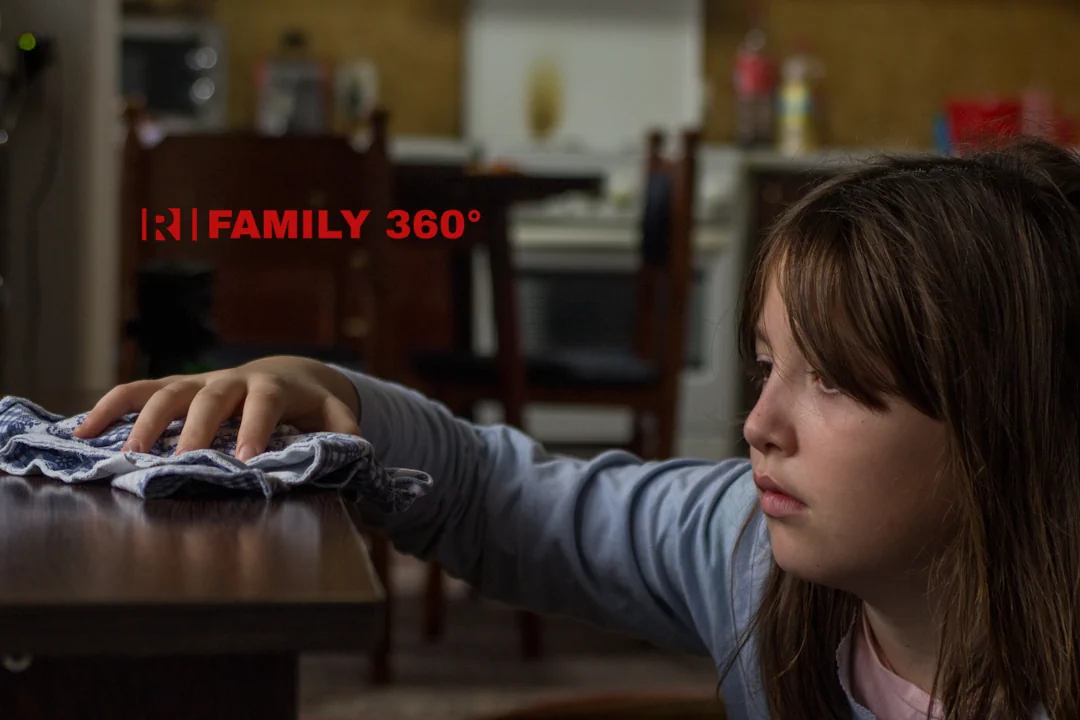09.11.2025
Are Ukrainian teenagers overburdened with household chores?

The fourth press release of the study ‘Changes in Children's Mental Health and Well-being’ is devoted to household chores. How much are Ukrainian teenagers burdened with household chores and how does this affect their psychological state?
In October 2025, Rating Group/Rating Lab surveyed more than 1,500 teenagers aged 10-18 and their parents using the unique Family 360° family research technology. In each publication, we discuss the mental health of teenagers and various aspects of their lives: gadgets and AI, emotional recognition by parents, dreams, household chores and stress, upbringing and punishment in the family, and bullying.
How much are children burdened with household chores?
- 56% of teenagers aged 10-18 often clean, wash dishes and do laundry. Another 21% do this from time to time, and 23% rarely or almost never.
- A little over a third of teenagers (36%) often cook meals. In contrast, 22% do so moderately, and 42% rarely cook.
- Slightly more teenagers take care of pets (here and further in this context, the percentage of children whose families have pets is given): 57% do this often, 21% do it moderately often, and 22% do it rarely.
However, it is important to look at the ‘extreme’ categories here:
- 13% of teenagers are constantly busy cleaning, washing dishes and doing laundry;
- 5% of teenagers are constantly involved in cooking;
- 18% constantly look after pets.
The role of gender stereotypes: girls are significantly more burdened than boys
- The vast majority of girls (65%) often do housework, while only half of boys (47%) do so. Among girls aged 14-18, 75% often do housework.
- Also, 44% of girls are often involved in cooking. In contrast, 28% of boys often cook. At the same time, younger girls aged 10-13 are as burdened with cooking as older boys aged 14-18 (in both categories, more than a third of teenagers often cook).
- Girls even take better care of pets: 61% of girls and 52% of boys do this often.
Are household chores harmful to children?
In general, household chores are beneficial. They contribute to the development of discipline, independence, the ability to achieve success (‘there were dirty dishes, I washed them – now they're gone’ is a clear example of early achievements), and the ability to maintain cleanliness.
In fact, children who never participate in household chores have lower stress resistance.
For example, among those who never cook, 61% have good stress resistance (resilience). Among teenagers who cook moderately often, this figure is around 75-77%.
But overloading a child is also harmful to their mental state. This is especially harmful to girls, as they are even more burdened with household chores.
Among teenagers who are constantly cleaning, washing dishes, and doing laundry, almost half (47%) experience significant stress. Among their peers who are less burdened with cleaning, this figure is significantly lower – 35%.
In general, it is best for a child's mental health to find a ‘happy medium’ when it comes to household chores. If a teenager is involved from time to time in cleaning or cooking, for example, this can be a good solution. The main thing is not to burden the child with excessive household responsibilities and not to take away their time for hobbies, socialising with friends, and childhood.
About Family 360° technology
It is not worth making conclusions about teenagers without asking their opinion. That is why the Rating Group team launched Family 360° technology for family surveys, which focuses on the child who is being surveyed, as well as their parents, family members and, in some cases, teachers, doctors, psychologists, etc. Comparing the answers of children and their parents allows us to understand the relationships and changes within the family. We have previously used this approach successfully with our partners at UNICEF, KSE, and Ty Yak? when researching mine awareness, mental health, education, and career guidance.
About the study
We first researched the topic of mental health in the parent-child context in October 2024. This year, we decided to continue, expanding the topic and using longitudinal research techniques to better understand the dynamics. In October 2025, this survey covered more than 1,500 children/adolescents aged 10-18 and their parents.
Authors of the research idea: Svitlana Roiz, child and family psychologist, mother of two; Marianna Tkalych, CEO of Rating Lab, Doctor of Psychological Sciences, mother of Masha (17 years old); and Tetiana Skrypchenko, Deputy Director of Rating Group, mother of Solomiia (8 months old).
Methodology
- Fieldwork dates: 3–7 October 2025
- Survey method: CATI>CAWI (Computer-Assisted Telephone Interview – telephone interviews using a computer, CAWI – online survey). In the first stage (CATI), contact was made with parents who gave their consent for their children to participate in the online survey. In the second stage, children completed the survey via a personal link. After that, parents received a personal invitation to take part in an online survey for parents.
- Sample size: 2,531 respondents. Of these, 1,572 were children aged 10-18 and 959 were their parents. Almost 900 children took part in the survey again in a longitudinal format.


